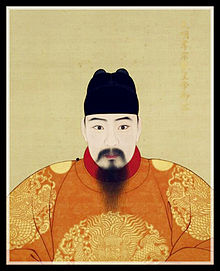Modern Supermarket (Credit:
William Perlman)
(Credit:
William Perlman)
Ice Cream Sundae
-
Sugar - India. First cystalyized sugar made from cane sugar juice produced in India c. 450 CE
-
Vanilla - Mexico. Made from the seed pod of the vanilla orchid.
-
Maraschino cherry
-
Edible cherries come from Europe and West Asia
-
Marachino has its origin in Croatia
-
-
Chocolate - Amazonian Peru. Cacao tree first domesticated in the Amazonian region near the Peruvian-Brazilian border
-
Cow milk - Turkey. Cattle fist domesticated in Turkey approximately 10,000 years ago
-
Peanuts - Argeninta and Bolivia.
-
This man could not get an ice cream sundae when he was a kid (realistically, never in his lifetime) Zh Youcheng, the Hongzhi Emperor of China, Ming Dynasty (1487-1505)

The "Columbian" Exchange (1492-the present)
-
Creating permanent trade between Americas and rest of world creates profound changes
-
Planets native to each area are exchanges
-
Animals make the same journey
-
as do pathogens - bacteria, viruses, etc.
-
-
Named after Columbus
-
Columbus establishes the first permanent trans-Atlantic route
-
But more than the trans-Atlantic route is at work
-
Increased interchange between regions within continents
-
frontier expansion in Asia and the Americas
-
trans-oceanic routes develop in the Pacific
-
Pacific islands and Australia linked to outside world
-
-
Ecological effects - Foodstuffs
-
From Europe/Africa/Asia to the Americas (a partial list)
-
wheat
-
rice
-
bananas
-
citrus fruits
-
apples, pears, apricots, peaches, plums, cherries
-
olives
-
wine grapes
-
cattle, sheep, goats, pigs, chickens
-
-
From the Americas to the rest of the world (a partial list)
-
corn (the book uses the word "maize")
-
potatoes and sweet potatoes
-
cassava (also called manioc or yucca)
-
peanuts
-
tomatoes
-
chilies
-
turkey
-
-
Impact of new foods on Europe/Africa/Asia
-
Corn/Maize becomes popular because of high calorie per acre value, and needs little labor
-
Potatoes, able to grow in cold climate and poor soils, become important in northern Europe and in Bengal
-
Sweet potatoes, also able to grow in poor soil, become important in East Asia
-
Cassava becomes important in West Africa
-
All of these lead to growing populations, especially in Europe and Asia
-
Specialty crops like tomatoes and chilies transform regional cuisines, but have less impact on population
-
-
Impact of new foodstuffs on Americas
-
Grasslands of much of the Americas transformed into ranchland of animals brought by Europeans
-
Introduction of wheat, meant to satisfy colonists tastes, transforms landscape but has modest impact on population (in part because of imported diseases)
-
Ecological Exchange - Commercial crops
-
Cane sugar
-
Cane sugar, brought to the Caribbean, is the first of the major plantation crops
-
Creates a viable products for trans-Atlantic trade
-
encourages widespread colonization in tropical zones and massive importation of African slave labor
-
-
Tobacco and Coffee in the Americas
-
Tobacco originates in North America; Coffee in East Africa and Middle East
-
Allow for plantation agriculture in temperate regions
-
Makes possible viable colonies in places like British North America and mountainous areas of Caribbean and South America
-
-
Chocolate and coffee around the world
-
both plants become plantation crops around the world
-
this becomes possible in part because of trade routes created by cane sugar
-
Ecological Exchange - Pathogens
-
Pathogens in the Americas
-
Amerindians lacked immunity to many diseases
-
Big killers were smallpox and influenza, but many other diseases new to the Americas
-
1500-1600 saw a population drop in the Americas of between 60 and 90%
-
Worst hit areas see the largest influx of Europeans, both as a cause and as a result
-
-
Pathogens in Eurasian frontiers and the Pacific
-
expanding imperial frontiers in Siberia and central Asia have a similar impact
-
the most isolated regions, like Pacific islands, are often the worst hit
-
increased trade routes over more areas of the globe see also increased incidents or epidemics of more familiar diseases
-
The Great Migrations
-
The Americas
-
Declining Amerindian populations allowed for increased European immigration
-
Poor life expectancies among all groups led to coerced labor importation (slavery and indentured servitude)
-
African slavery starts first in Spanish Caribbean (by 1510) spreading to Portuguese America (Brazil) and beyond
-
In time, millions (roughly 10-12) of Africans are transported to coastal zones of tropical and sub-tropical North and South America
-
European migration is more modest until the 19th and 20th centuries, and tends to focus on temperate and highland regions
-
-
Expansion of settlement in Europe and Asia
-
China and Russian both initiate settlement policies in their expanding frontiers
-
Settlement takes place at the expense of herders and hunter gathers, and spreads disease to these people
-
Independent emigration of Chinese begins to transform the populations of Southeast Asia, particularly the port cities
-
-
Continued Expansion in Africa and the Americas
-
Spanish and British expand settlement steadily from 1600s forward, generally taking land from herders and small farmers
-
More powerful African states, particularly those with access to global trade routes, follow a similar pattern
-
French and British establish trade ports for fur products deep in North America, notably in modern Canada
-
These patterns also contribute to the expansion of disease
-